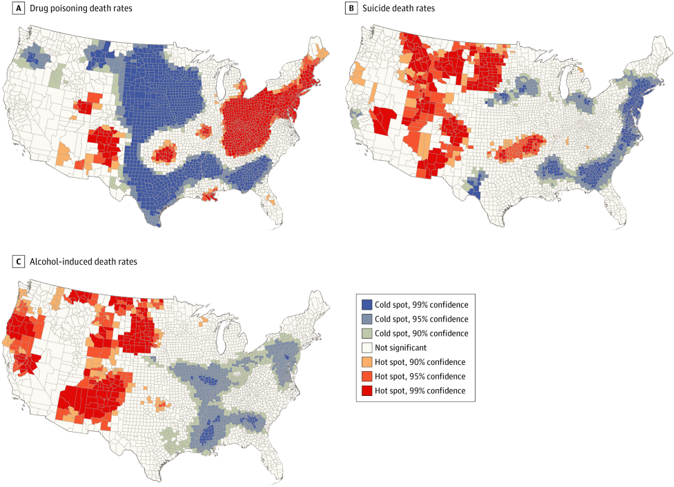Patterns in “Deaths of Despair” Vary by Geography and Demographics
, by DCEG Staff
Over the last several years, U.S. life expectancy has decreased, driven largely by increases in ‘deaths of despair,’ a term that collectively includes deaths by drug poisoning, suicide, and alcohol. Meredith Shiels, Ph.D., tenure-track investigator in the Infections and Immunoepidemiology Branch, and colleagues, investigated whether patterns and trends from these causes of death varied by different geographic and demographic factors in 2000-2017. The findings were published in JAMA Network Open on September 11, 2020.
The investigators found that during 2000-2017, there were 450,000 more deaths than expected from drug poisoning, suicide, and alcohol. While drug poisoning and alcohol-induced deaths surged recently, there has been constant growth in deaths from suicide. The highest drug poisoning deaths rates were found in the Northeast through Appalachia, while suicide and alcohol-related deaths were concentrated in the West. In age comparisons, drug poisoning was more common in 35-49-year-olds, whereas suicide and alcohol-induced deaths increased with age and peaked among 50-64-year-olds. In addition, the authors found that death rates increased across different racial and ethnic groups, though trajectories varied.
Results from this study show that recent increases in drug poisoning, suicide and alcohol-related death rates differ by demographic and geographic factors in the U.S. These reported patterns add to the complexity of this public health issue and emphasize the need for targeted efforts to reverse the alarming trends in these causes of death.
Reference:
Shiels M et al. Trends in mortality from drug poisoning, suicide and alcohol-induced deaths in the United States 2000-2017. JAMA Network Open. September 11, 2020. DOI: 10.1001/jamanetworkopen.2020.16217. [E-pub ahead of print]
